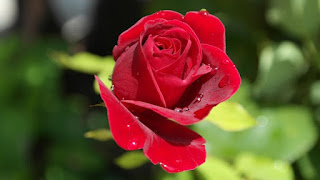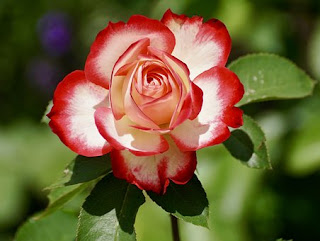 |
| rose - www.healthnote25.com |
Roses are
a kind of bush plant of the genus Rosa as well as the name of the flower
produced by this plant. Wild roses are composed of over 100 species, mostly
grown in the cool cool northern hemisphere.
The rose species are
generally bushes of thorns or climbing plants that can reach up to 2 to 5
meters tall. Although rarely encountered, the height of rose plants that
propagate in other plants can reach 20 meters.
Most species have leaves
that are between 5-15 cm long with two or two opposites (pinnate). Leaf
compound which each leaf consists of at least 3 or 5 to 9 or 13 leaflets and
leaf-shaped limbs (stipula) are oval, pinnate bone, edges of beringgit edges,
tapered at the tip of the leaf and spiked on the stem close to the ground.
Roses are not actually tropical plants, most of the species threshing the
leaves and only a few species in Southeast Asia are always green leafy
throughout the year.
The flowers consist of 5
pieces of crown leaves with the exception of Rosa sericea which only has 4
pieces of crown leaf. Among the colors that are owned by roses are white, pink,
yellow and blue in some species. Ovary is at the bottom of the crown and leaves
of the petals.
Flowers produce an aggregate
fruit (evolved from one flower with many pistils) called rose hips. Each pistil
develops into a single fruit (achene), whereas a single fruit bundle is wrapped
in fruit flesh on the outside.
Species with wide open
flowers are more inviting the arrival of bees or other insects that help
pollinate so tend to produce more fruit. Rose breeding yields flowers whose
crown leaves are closed tightly making it difficult to pollinate. Some roses
are red with some exceptions such as Rosa pimpinellifolia that produce dark
purple to black fruits.
 |
| rose - www.healthnote25 |
In some species such as Rosa
canina and Rosa rugosa produce very rich rose hips with vitamin C even among
the richest natural vitamin C sources. The rose hips are favored by
fruit-eating birds that help spread the seeds of roses with impurities removed.
Some bird species like the Finch also eat the seeds of roses.
In general, roses have a
hook-shaped spine that serves as a handle when climbing other plants. Some
species that grow wild in sandy soils in coastal areas such as Rosa rugosa and
Rosa pimpinellifolia adapt to straight thorns such as needles that might serve
to reduce the damage caused by animal feeding, retaining wind-blown sand and
protecting the roots from erosion. Although it is protected by thorns, deer do
not seem afraid and often damage the rose plants. Some species of roses have
undeveloped thorns and are not sharp.
Roses can be infected with
several diseases such as rust leaves which is the most serious disease. The
cause is a fungus Phragmidium mucronatum which causes leaf loss.
Less dangerous diseases such
as Mildew Flour are caused by the Sphaerotheca pannosa fungus, whereas the
Black Spotted disease is characterized by black spots on the leaves caused by
the Diplocarpon rosae fungus. Roses are also a food for larvae of several
species of Lepidoptera.
 |
| rose - www.healthnote25.com |
Roses flourish in temperate
climates although some cultivars that are the result of grafting methods can
grow in subtropical climates to tropical climates. As well as cut flowers,
roses have many benefits, including antidepressants, antivirals,
antibacterials, anti-inflammatories, and source of vitamin C. Rose oil is one
of the essential oils of distillation and evaporation of crown leaves so it can
be made into perfume. Roses can also be used for tea, jelly and jam.








0 Comments:
Post a Comment